Hello again, my food friend, and welcome to a discussion of butts.
In a lot of posts, I anticipate telling real-life things about me, like:
How I once refused to shake a certain politician’s hand on live TV.
How I danced on stage in a go-go cage in Paris with a famous rock band.
How I almost got trampled by a stampede caused by skinheads.
How I once sat on a cafe terrace with some journalists and watched a day of warfare.
How I got saved at the Wailing Wall.
So stay tuned, gentle reader. All those adventures and more are coming up in future weeks of this newsletter, but for now, I am here to talk about butts, and not in a cheeky way. Yes, that just happened. I apologize to you and the fine woman who bore you. That was uncalled for. Let me try again.
With apologies to Sir Mixalot and to you, gentle readers, I like big butts, pork butts. Indeed, even though I live in a household of two people and two dogs, not a family like we see in the Norman Rockwell drawing of a family at Thanksgiving, I like to buy big cuts of meat and poultry whenever I see a good sale price. Why? My husband and I don’t eat it all in one sitting. Instead, we eat it over time. I put pieces of the meat in the freezer, and what I cook for a first dish, I repurpose into multiple other dishes. If I were to buy little pieces of meat, I would pay perhaps triple the price over time. Instead, with the help of my imagination and the freezer, I can save money, and so can you.
Allow me to confess that I am really immature about butt references, and as I write this, I am hearing the characters Beavis and Butthead laughing (Heh heh! She said butt roast). I chose a butt roast because it’s an inexpensive cut of meat but it is tender when cooked right.
Here is the first dish I cooked:
This is a traditional pork roast braised in white wine with a mirepoix, herbs and potatoes.
Here are the steps I took to make this roast:
First, I sprinkled the butt roast (heh, heh — she said sprinkled the butt!) with salt and pepper. I put the roast in a Dutch Oven with a bit of vegetable oil, and I browned it on all sides at high heat over the range.
Then, I took out the roast itself, turned down the heat in the pan, which was now filled with meat drippings, and I added about a cup of white wine (I used a light wine — a Pinot Grigio — but you could really use any wine you like, even beer), and I deglazed the pan with it, scraping any bits off the bottom while the alcohol boils off.
Then I turned off the heat. I threw into the pot a chopped up leek, an onion, half a bag of baby carrots, three stocks of celery chopped, and the mini potatoes that you see here. Any potatoes, even sweet potatoes, could go in if chopped, but I liked that I didn’t have to chop these. The French call this a mirepoix, a medley of vegetables that accompany the roasting or braising of a piece of meat so that it flavors the meat. To the wine and vegetables, I added a cup of beef stock, thyme, garlic and fresh parsley that I chopped.
I set the oven low — 300 degrees Fahrenheit, as I intended to braise it in this liquid slowly. I put it in to slowly braise. Every hour, I opened the Dutch Oven and added about 3/4 of a cup of stock. I cooked it for four and a half hours or so.
It looked like thIs in the end:
At the same time I was cooking the roast, I also cooked some baby broccoli using the same wine I used to braise the pork. I put it in the same oven with the roast and kept it in there for an hour.
In the end, Here is what it looked like:
I also took some more of the herbs I had chopped, put them in a bowl, added a tiny bit of mustard, some salt, pepper, paprika, and the juice of two lemons. I added 3/4 of a cup of vegetable oil. I mixed this up to have a lemon vinaigrette salad dressing.
For the salad on which I would put it on, I took a head of lettuce and chopped it. I also chopped some more stalks of celery and about a half dozen baby carrots. I took as much of the salad as I thought we would eat that evening, and I tossed it in a few spoonfuls of the vinaigrette.
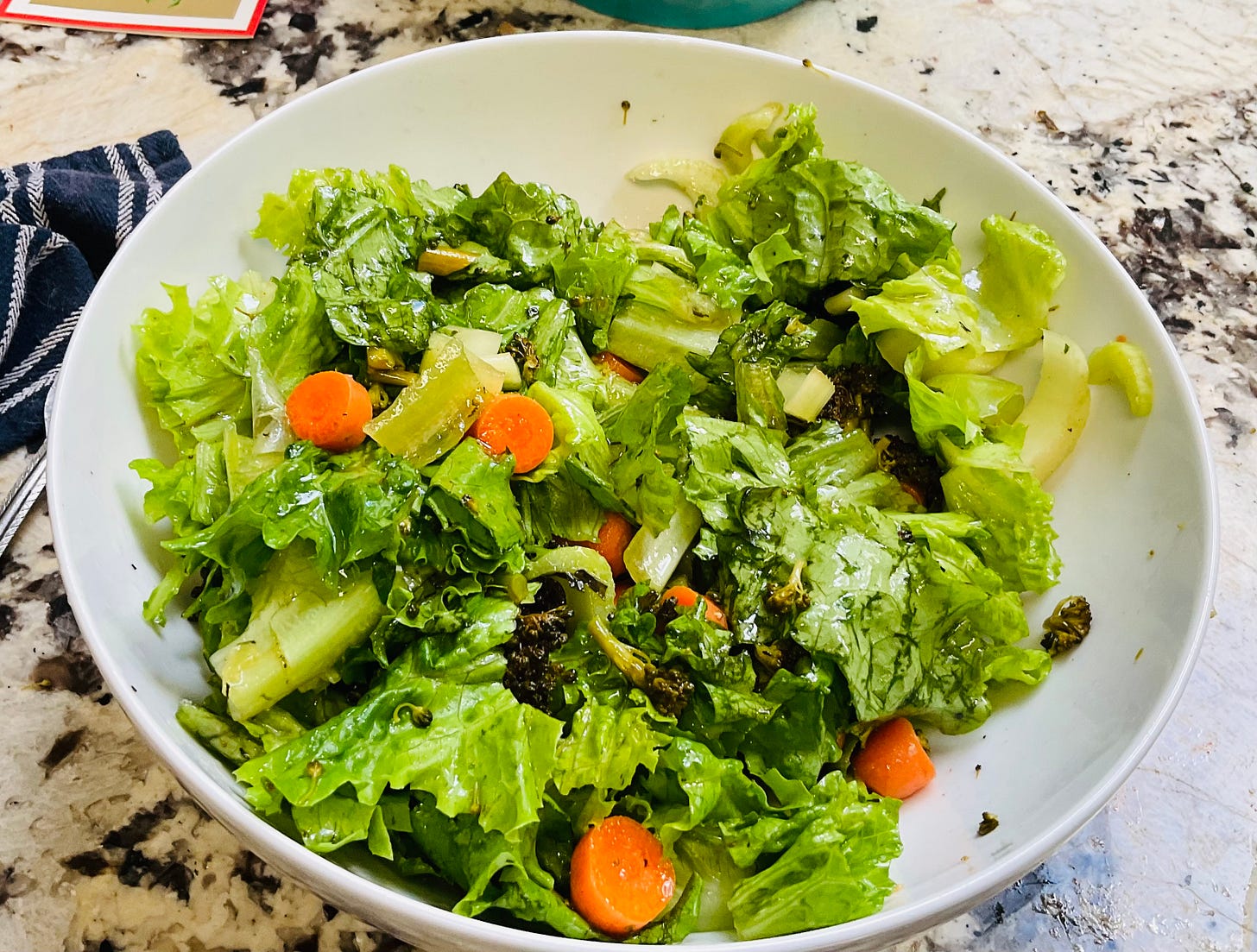
That was the first dinner I got out of the pork butt.
As I was cleaning up that night, I divided the Dutch oven’s contents into three — I put the meat in a bag by itself, cut in two, one portion that was larger, another that was smaller. Then I put the potatoes in their own bowl and added a little additional chopped parsley, salt and pepper, and I kept the mirepoix vegetables together so that I could make a traditional Louisiana dish with a new inflection. The only thing I dumped out were the pan drippings. For what I was going to make the next day, the pan drippings were already sufficiently saturating the mirepoix vegetables that cooked with the pork.
Here’s what I did for a second meal —
My husband spent a lot of his life in Texas, and he loves Texas-style barbecue sauce. I took the larger portion of the meat left over, and I pulled it into shreds. Then I added two chopped onions with it, and I put it in my crock pot with a cup of red wine and a cup and a half of barbecue sauce. I added additional paprika. I might have added a bit of honey if I had wanted it to be sweeter or hot sauce if I had wanted it to be hotter, but I thought the sauce I bought was hot enough and sweet enough (just like me, of course).
I cooked this on high in the crock pot for about two hours. When you do this, cook it until the onions are clear. I put the meat on hamburger buns, and with it I served plain white rice that I cooked in a rice cooker, and I took the the mirepoix vegetables from the previous evening, and I threw them in the pot with some lentils and a bunch of paprika.
I added four cups of chicken stock and let the pot simmer at a low boil for about a half hour. At that point, I added 32 ounces of canned corn and several heaping teaspoons of minced garlic. I let the pot simmer down. I added plenty of pepper and paprika, a bit of thyme and parsley, but if I liked things hotter (and more traditionally Louisianan) I would have added some Tabasco sauce or hot sauce. I like things milder, but you could definitely do that.
Here’s what it looked like when it was close to finished:
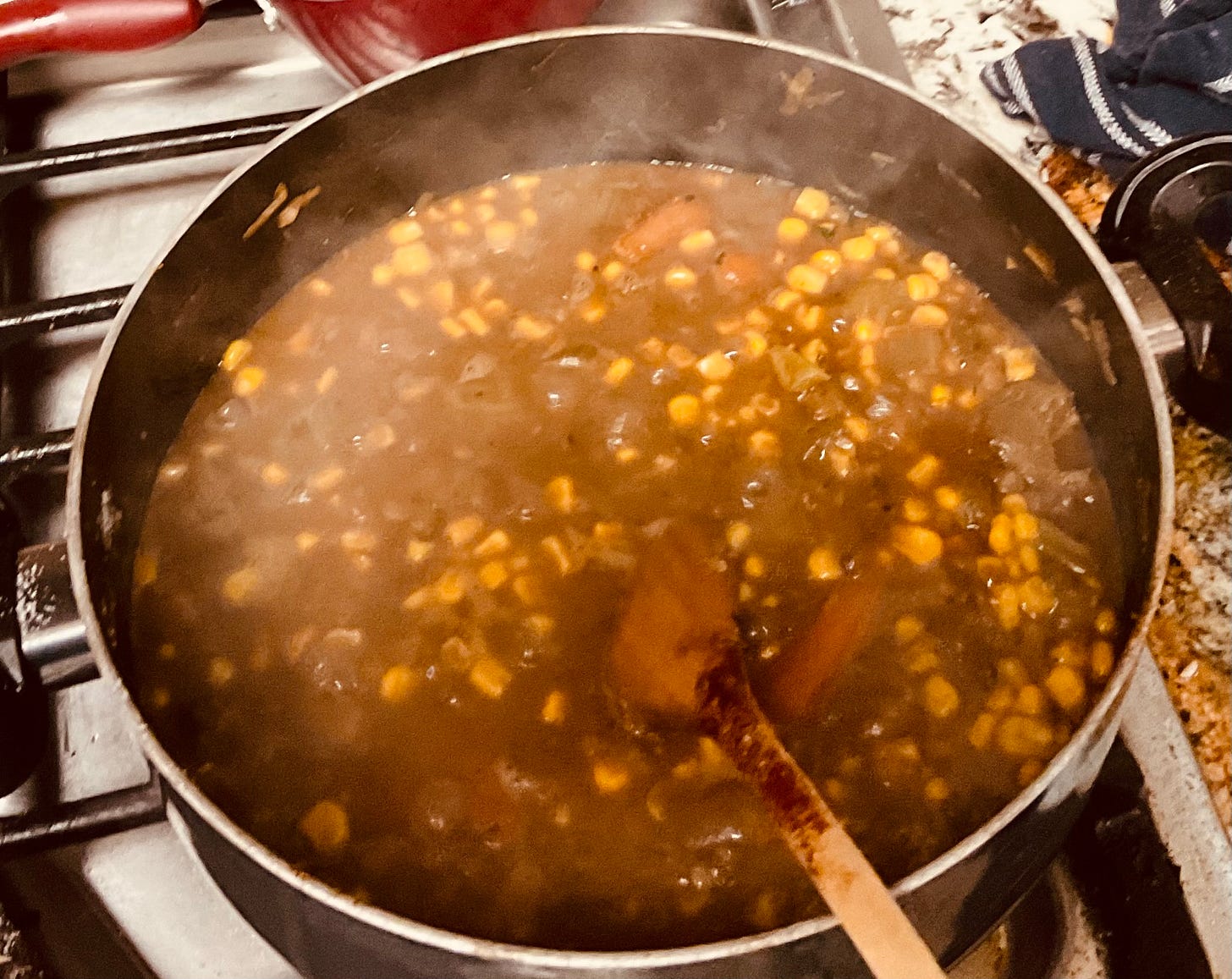
This is a revision of an old Louisianan dish called Maque Choux, which normally does not include lentils, just corn. It used to include pork drippings, though, but in an era where my exercise routine does not include plowing the back 40 or breaking a wild stallion, I figured I would make it slightly less caloric than they did, as they say in Louisiana, à l’ancienne, that is kicking it old school.
So we had with the leftovers and a few new ingredients:
Barbecued pulled pork on buns
Rice
Lentil Maque Choux
And I added the florets from the broccoli to the salad from the night before, which I served with more lemon vinaigrette. I chopped up the stems, though, for the next evening’s dinner.
Before I went to bed that night, I took the last bit of pork butt and cubed it. I put it in a plastic container with a bit of hoisin sauce to marinate overnight in the fridge.
The next night, I chopped up the rest of the onions in the bag I had bought, and I sweated them in vegetable oil until they had started to turn brown but had not completely browned. Here’s what that looked like:
I took the leftover rice and broke it up so that it wasn’t in glutinous lumps. I sautéed the rice with the onions, and I added soy sauce, chopped celery, the stems of the baby broccoli that I had chopped up, chopped baby carrots and a chopped leek. I stir-fried the lot, adding more soy sauce as I cooked. Finally, I added the hoisin-marinated pork cubes, and mixed them in for a few more minutes of cooking. Once it was done, I added chopped parsley.
In the end, it looked like this:
I took the bag of edamame I got at the grocery store and microwaved it so that it was ready to eat with a bit of salt added. The rice you see above is VERY filling, so with the last bit of salad and the edamame, we were both full. It was a simpler meal than the first one, but it was no less hearty.
So here is the journey one pork butt roast took through three different dinners. Not every issue of this newsletter will be so full of recipes. But seeing how we haven’t cooked together before, I thought I would give you a LOT of ideas about how you might try new things in your own kitchens.
I am going to give you the list of groceries for what I buy for the home-cooked food I show you here, and this may help you think of your own budget. I tend to select meals based on what is fresh, what is on sale. Great French chefs have called this style of menu selection and cooking « faire une cuisine du marché », but I honestly think this is what most American cooks simply call making meals that are practical for one’s family, without the French snootiness about it.
In any case, what follows is a grocery list. I have shown you what I have to show you this week. I hope you have a wonderful meal at home with someone wonderful to talk to this week. May your food be blessed, my food friends!
Here is your grocery list for the week, food friends! I will be producing some kind of grocery list for you every other week here, maybe more often. I won’t always have a big butt roast or other piece of meat to discuss with you, but I will always help you know what to shop for if you want to make the food you see here.
I am assuming you have these common kitchen staples in your pantry already:
Salt , Pepper, Mustard, Soy sauce, Hot sauce (if you like hot sauce), Vegetable oil (a bottle of it, NOT a spray. We are going to use some fat in this cooking process because fat carries flavor)
If you don’t have them, add them to your grocery list.
Shopping list for week of January 17
MEAT
Pork butt roast (4-5 pounds)
FRESH PRODUCE
2 pound bag of Onions
Celery
A bag of baby Carrots
Leeks
Broccolini (sometimes called broccoletti or baby broccoli) — one bunch
A head of lettuce
Parsley
3 lemons (or more — I usually find extra uses for them as I cook)
FROZEN PRODUCE
1 bag of Frozen Edamame
DRIED/CANNED GOODS
A 32 oz can of corn
A bag of dried lentils
4 cups of beef stock (that’s one of those rectangular cartons of broth that groceries sell) and
4 cups of chicken stock (just one of those rectangular cartons)
SAUCES AND SEASONINGS
A jar of barbecue sauce (unless you feel ready to mix your own, which is time-consuming)
A jar of Hoisin Sauce
Dried thyme
Paprika
Garlic (I would suggest a jar of minced garlic that you can keep in your fridge)
WINE
A bottle of pinot Grigio
A bottle of any red wine you like (I used Shiraz here)
At my grocery store this week, this runs $75 dollars or so, BUT this presumes you need to buy ALL these ingredients, and it is likely you have at least some of them already. If you already have things like rice and minced garlic, the price is lower.
This is going to produce 3 complete dinners for two people this week, including a glass of wine for each person at each meal — for a total of six meals.
Have more people in your household? Get a bigger pork butt roast than the one I recommend (I like big butts, and I cannot lie). You might need a couple more leeks. Otherwise, you can expand the number of people served as needed.
At the end of the week you will likely have leftover salt, pepper, paprika, vegetable oil, thyme, garlic, barbecue sauce, soy sauce, hoisin sauce, rice, lentils, and hot sauce (should you choose to use it). These will all keep for a long time. I think you will also have leftover some of the maque choux, the fried rice, and the salad dressing — all of which you might eat for lunch.
Put the hoisin sauce, barbecue sauce, and the jar of garlic in the fridge. The rice grains and dried lentils will keep nicely in a dry place, as will the seasonings and the oil. I will give you a new grocery list next week.
RECIPES
Traditional Pork Roast
4-5 Pound roast
2 pounds of small potatoes
3 stalks of celery, chopped
1 leek, chopped
12 baby carrots
2-3 onions, chopped
1/3 cup vegetable oil
3-5 cups of white wine
Parsley to taste
Thyme to taste
Garlic to taste
Salt and pepper to taste
Set Oven to 300 degrees
Salt and Pepper the roast. Put the oil in a Dutch oven, and brown the roast on all sides over a high heat on the stove top
Remove the roast from the Dutch Oven, and put it to the side. Lower the heat under the Dutch Oven, and pour in a cup of wine. Scrape the bottom of the pan for any small pieces of meat that have gotten stuck there. Let this simmer until the alcohol smell ceases to be strong coming out of the Dutch Oven over the heat. Then turn off the stove top.
Add first the potatoes, then the vegetables to the Dutch oven. Put the roast back in the Dutch Oven and put the lid on.
Bake in the oven for 4-5 hours. Every hour, add between 1/2 a cup and 1 cup of wine to the Dutch Oven. It should be ready in about 4 1/2 hours.
Braised baby broccoli
1 bunch of baby broccoli (sometimes called “Broccolini” or “broccoletti.”
1 cup of white wine
Salt and pepper
Put the baby broccoli in a pan
Pour in the wine. Add salt and pepper
Bake with the roast for an hour at 300 degrees.
Lemon Vinaigrette
The juice of 2 lemons
1/2 teaspoon of mustard
Chopped parsley and thyme
Salt and pepper
3/4 cup of vegetable oil
Mix all the above ingredients together. That’s the whole recipe.
Chopped Salad
1 head of lettuce, sliced
3-5 stalks of celery, chopped
7 baby carrots, chopped
Any other vegetables you like, chopped.
You know what to do. Toss all the ingredients together. Add the dressing of your choice, possibly the one above.
Herbed potatoes
Just take the potatoes you cooked with the roast, and add salt, pepper, and parsley.
Lentil Maque Choux
Roasted vegetables from the Dutch Oven where you cooked the pork
1 cup of lentils
4 cups of chicken broth
32 ounces of corn
Paprika to taste
Salt and pepper to taste
Parsley to taste
Garlic to taste
Hot sauce (optional) to taste
Remove the chopped vegetables (minus the potatoes) from the Dutch Oven where you cooked the roast. Put them in a new large pot.
Add the lentils and the chicken broth. Boil for about 20 minutes.
Add the corn and seasonings listed above. Boil for perhaps 10 more minutes until most of the chicken broth is reduced and absorbed.
Pulled barbecue pork and onions
2/3 of the leftover roast
2 onions, chopped
1 cup of red wine
2 cups (or so) of barbecue sauce
Take the roast meat and pull it apart with your fingers so that you have a stringy mess of meat.
Throw all the ingredients in a crock pot on high to bubble for about 2 hours.
Pork and rice stir-fried
1/3 of the leftover roast, cubed
1 cup of hoisin sauce
Leftover rice from the day you ate the pulled pork in barbecue sauce
2-3 onions, chopped.
The stems of leftover baby broccoli, chopped
7 baby carrots, chopped
2 stalks of celery, chopped
1 leek, chopped
1/2-3/4 cup of vegetable oil
2-3 cups of soy sauce.
1/4 cup minced garlic
Chopped parsley
The night before you make this dish, put the cubed pork in the hoisin sauce in a small container. Cover and refrigerate overnight to let it marinate.
Put the oil and the chopped onion in a large frying pan or wok. Let it brown slightly as shown in the photo above.
Add the garlic and all the other chopped vegetables, and stir fry them for about 5 minutes.
Crumble the leftover rice, and add it to the pan. Add liberal amounts of soy sauce while stir-frying.
When it is very nearly done, so that all the ingredients are lightly coated in soy sauce, add the parsley.




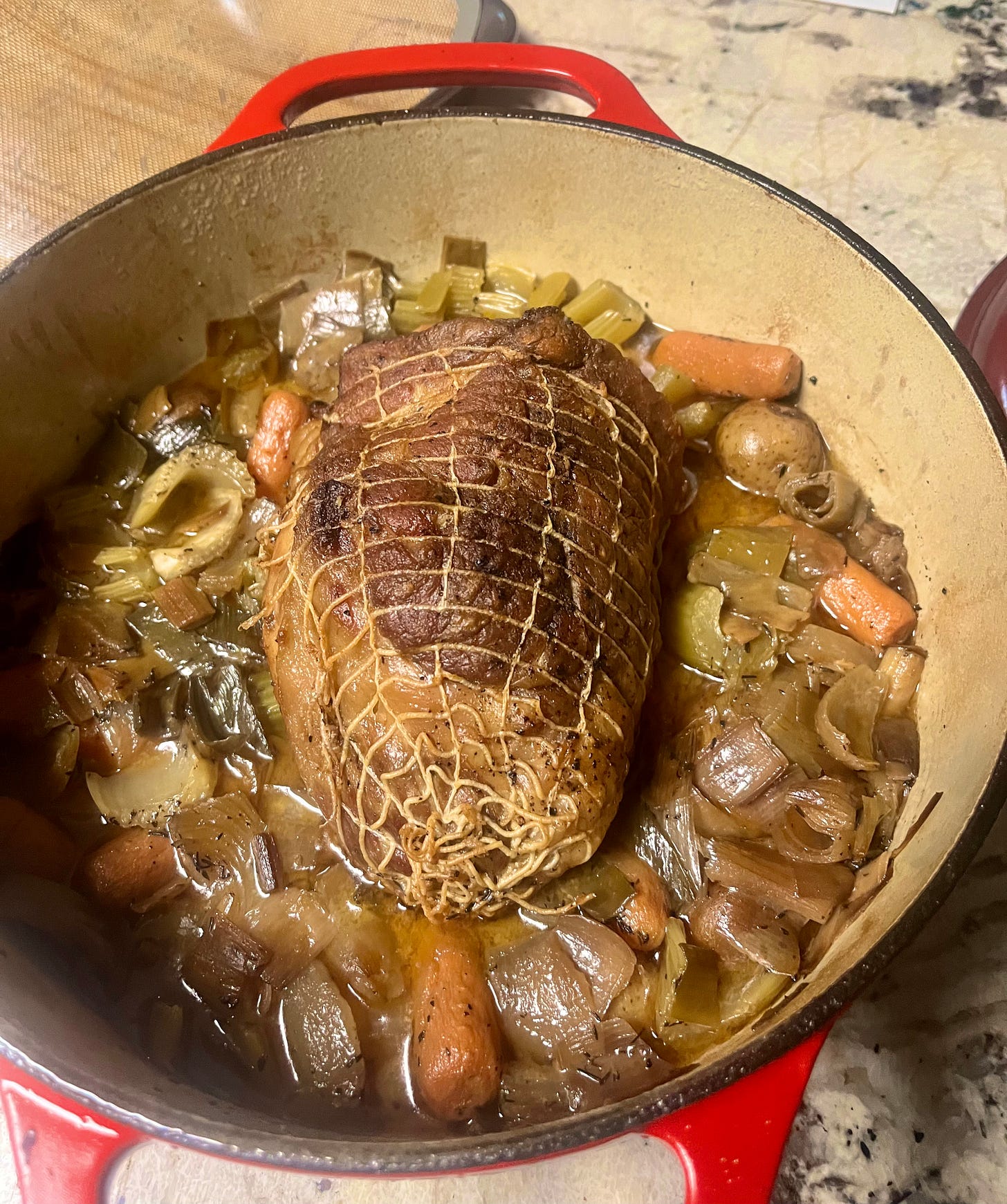


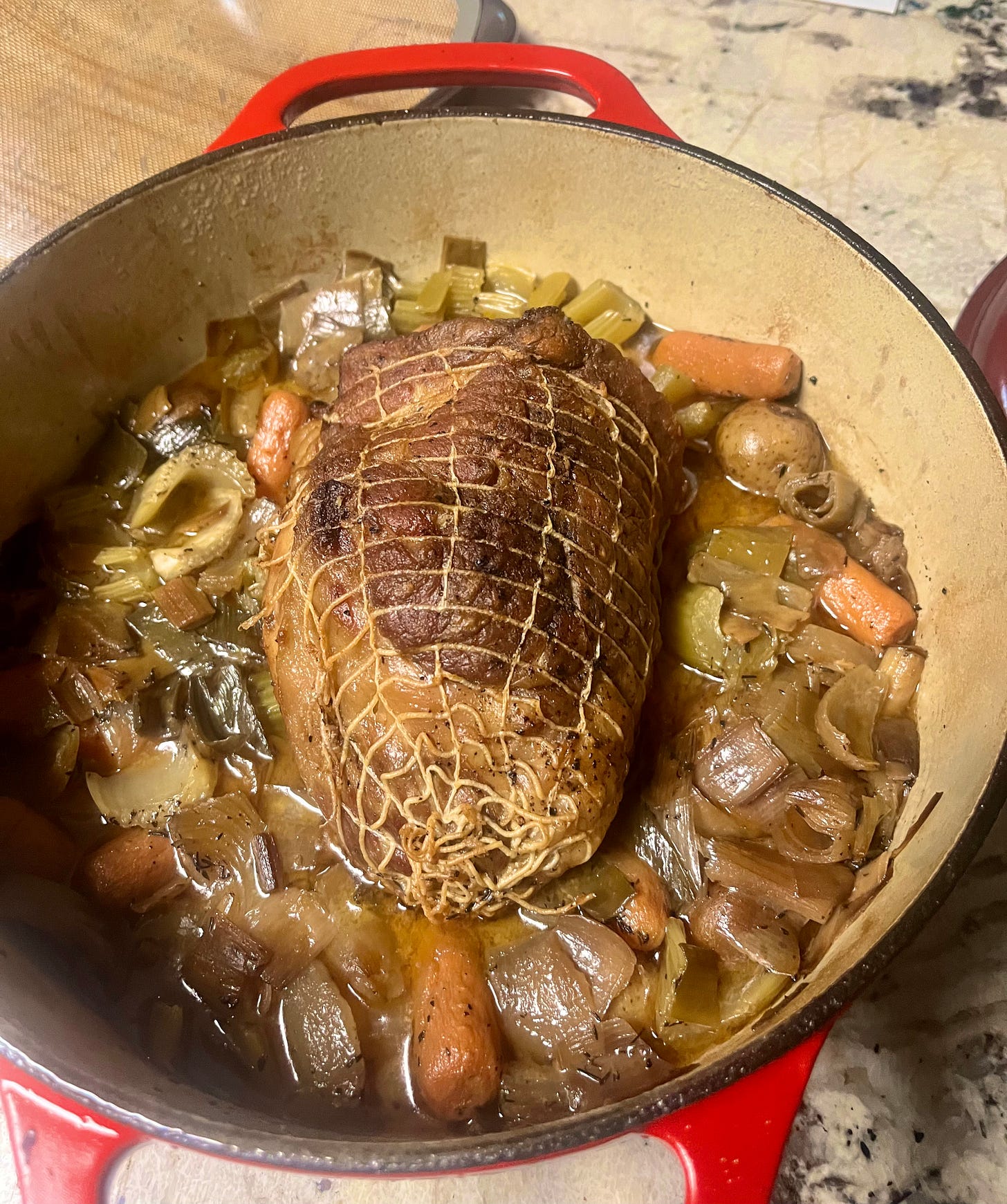
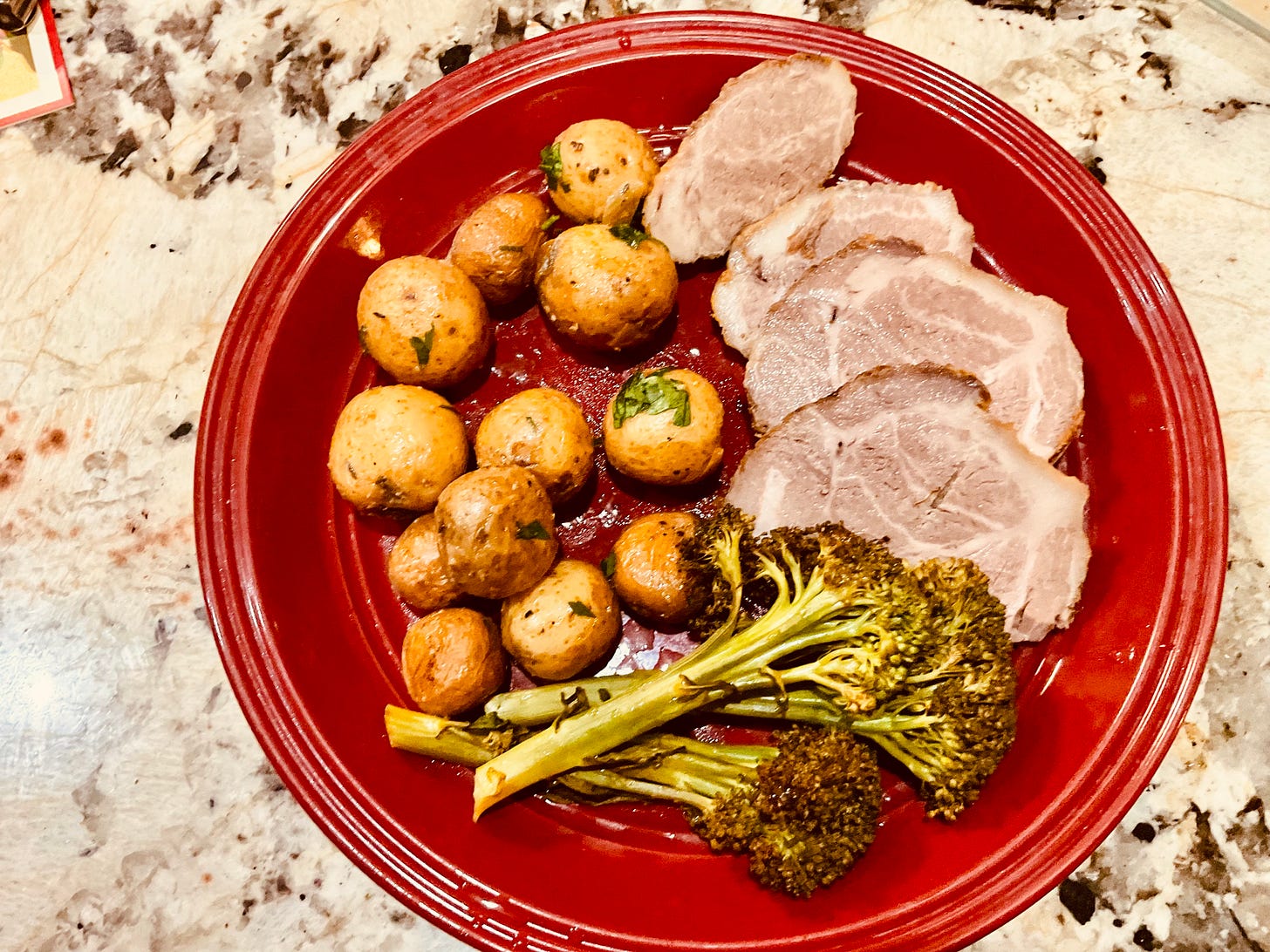


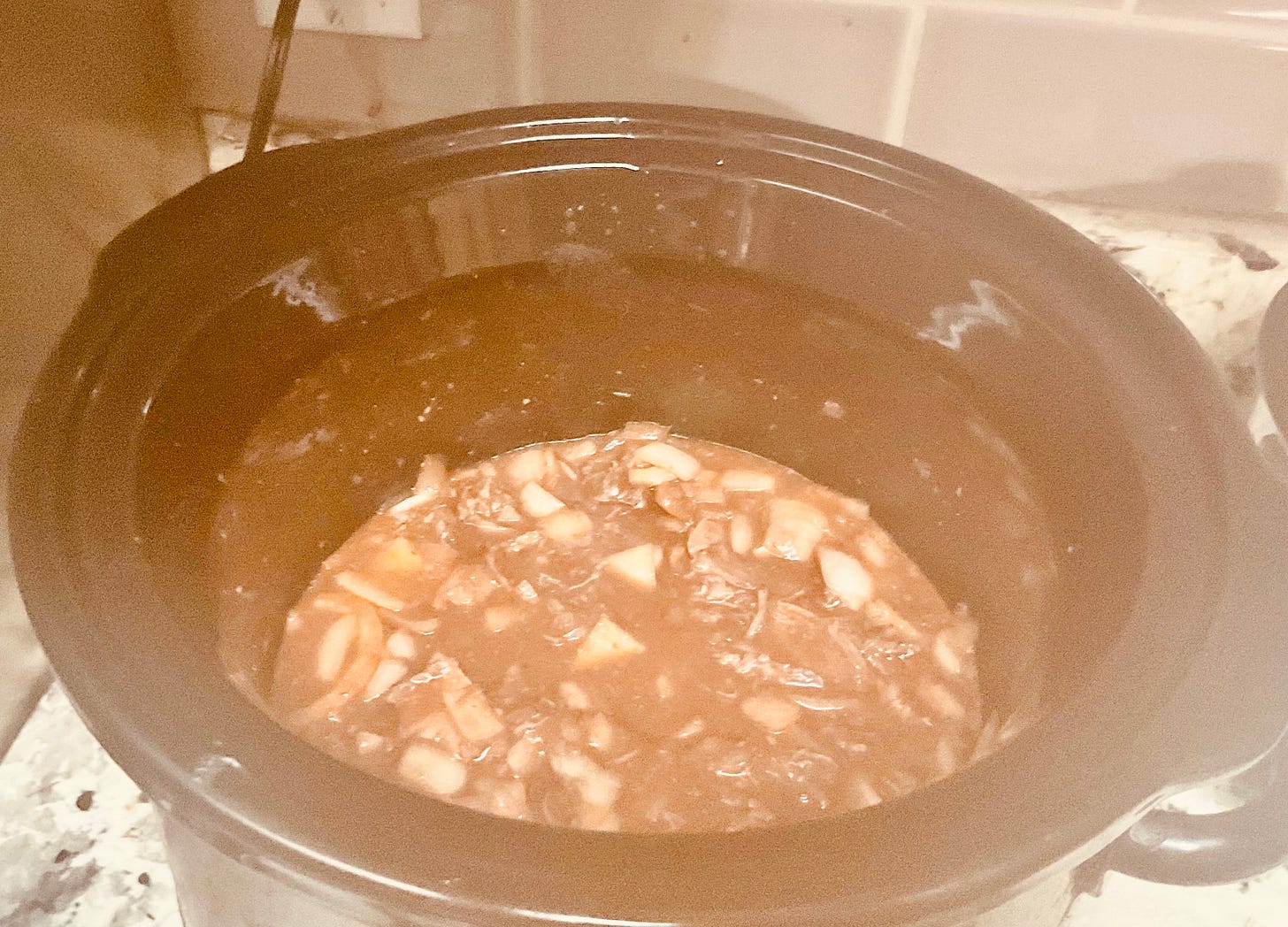
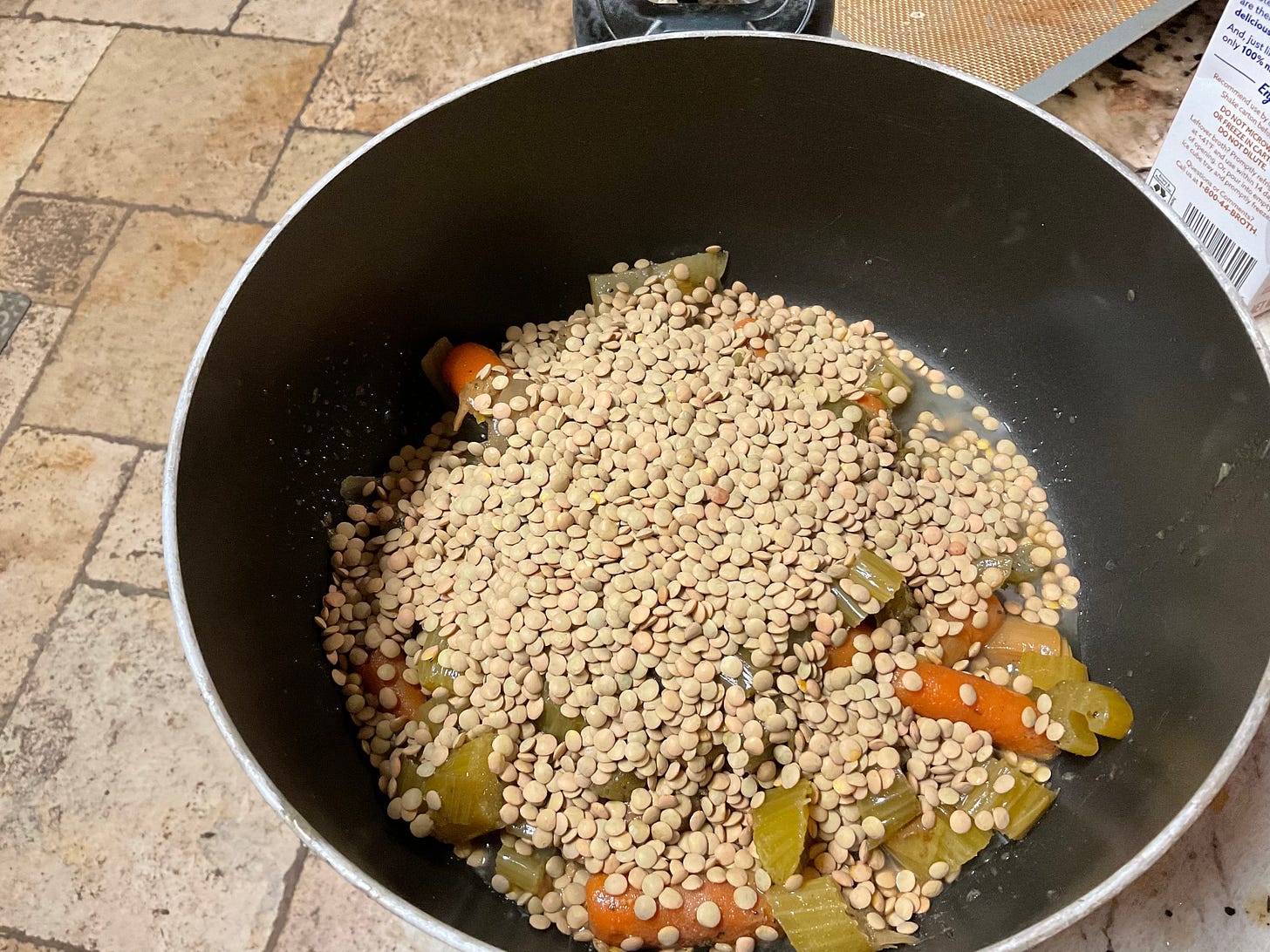
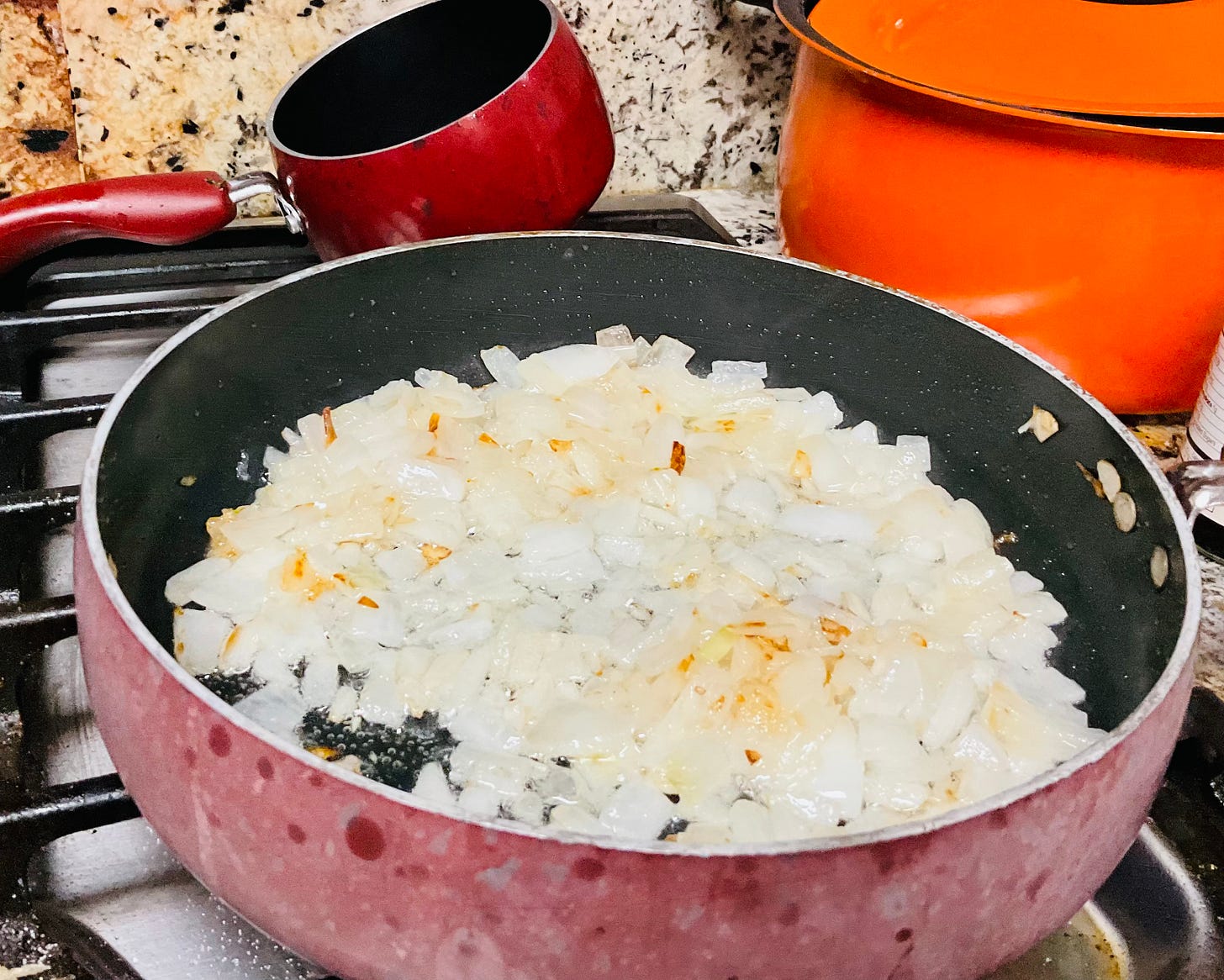


Yes, yes, and yes!
Brilliant Anne ! This is how I endeavor to cook. One note if I may: Tying the large roasts. Your butcher may do that for you.... or not. I was surprised when I learned that more folks than you'd expect don't know the why's or how's of roast tying. Brilliant no less, thank you !